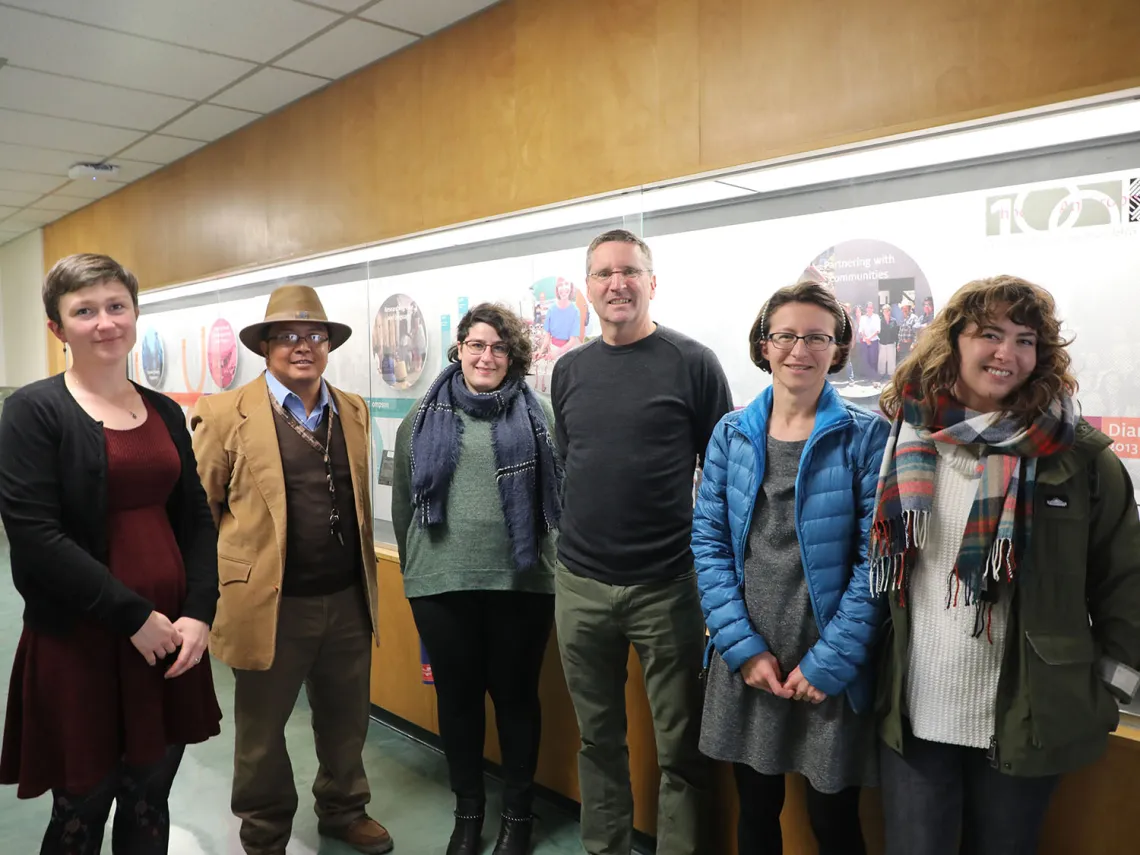The Evolving Role of Anthropologists in the Technology Industry

This spring, alumnus John Sherry (center) returned to the UA to speak to graduate students about the evolving role of anthropologists in the technology industry.
In 1994, John Sherry was living in the mountains on the Arizona/New Mexico border working on his dissertation. He was feeling indecisive about what he wanted to do after he completed his Ph.D. in anthropology from the University of Arizona. A contact sent him an email that Microsoft was looking for an anthropologist.
Sherry did have some background in technology. He had a B.S. in computer science, and he was doing research on a Navajo organization that was using technology in innovative ways as part of its environmental justice activism.
“So I called Microsoft, got the internship, and ended up in a career,” Sherry said.
When Sherry started in the field, there was only a scattering of anthropologists. Today, at least 600 anthropologists work in the tech industry.
“There is an increasing recognition on the value of anthropologists and ethnographic research in the industry,” Sherry said.
After two years at Microsoft, Sherry joined Intel Corporation in 1997 as the company’s first anthropologist. During his time at Intel, he has investigated the role of new technologies across a variety of settings, including salmon fishing in Alaska, growing old in the Mediterranean, street vending and farming in Morocco, and early childhood vaccination in northern India. As part of his work, Sherry has traveled to every continent.
Currently, he leads a team of designers, researchers and technologists in the User Experience Innovation Lab at Intel. The team is charged with discovering new applications of artificial intelligence, exploring techniques for human-machine interaction, and helping discern the larger social, economic and cultural implications of these new capabilities.
The value of ethnography in technology
Ethnography is defined as the recording and analysis of a culture or society. And it happens to fit in nicely with design thinking, a set of practices instrumental to innovation that includes understanding people and the complex systems they inhabit.
“These really are the exact types of things that anthropologists are best at,” Sherry said. “Going out into the world, understanding people’s lived experiences and then, structuring that info in a way that our colleagues who are designers or engineers can use to creatively solve problems.”
Sherry says even though his team collects extensive data, it is the stories coming out of the research that can often be most valuable.
“The particulars are so useful in firing the imagination about what is possible and also connecting my colleagues emotionally to the project,” Sherry said.
Sherry describes a project examining possible technologies to help aging adults stay healthy and in their homes longer. An older man from Italy who’d had three hip replacements told the researchers that he would lie in bed at night imagining the day when he could take the back steps to his garden again.
“We could relay that story to our colleagues to say ‘don’t design for infirmity, design for aspiration,’” Sherry said.
Another valuable skill anthropologists bring to the table is that they think in terms of systems, including cultural systems, and reveal the “messy lived experience” of people and how those impact technology use. Sherry said there is a “whole constellation of factors” that influence the interaction between a user and a gadget, including regulatory, socioeconomic, and infrastructure factors.
“Anthropologists are really good at thinking of all these things simultaneously,” Sherry said.
More than user experience
Sherry warned against limiting anthropologists and other social scientists to “user experience” roles.
“This label is both a blessing and curse,” Sherry said. “It has a tendency to pigeon-hole the kinds of contributions that anthropologists might be asked to – or even allowed to – provide.”
Sherry said that, unfortunately, some in the field approach ethnography as “Let’s just get someone in the field who is our human tape recorder.”
Anthropologists also bring theory to problems. “Ethnographic research is not just about being the eyes and ears of the design team. We have a point of view. And this point of view has informed my work throughout my career.”
Sherry argues that the contributions of social scientists, particularly anthropologists, extend well beyond user experience. With the advent of artificial intelligence, the technology industry is undergoing a shift in how it thinks about the relationship between humans and technology.
What has changed in the last decade is the emergence of deep learning, which is an approach to computation that simulates how neurons work. A computer can learn from itself. Deep learning has contributed to products such as speech recognition in Alexa and computer vision in self-driving cars. These systems do well in controlled environments but can wobble in messy real-life situations.
Anthropologists and other social scientists can provide valuable expertise on the larger societal implications of AI technology, on topics ranging from ethics to cultural bias to privacy concerns.
“New technologies are changing the world along so many dimensions, not just in terms of personal experiences but affecting our economies, our political systems, our whole social fabric,” Sherry said. “We need smart anthropologists thinking about impacts and helping us identify more equitable and humane futures. Luckily, a lot of companies are starting to wake up to this as well.”
About UX@UA
Students, faculty and staff at the UA interested in user experience (UX) can join the UX@UA group, which discusses user research, UX/UI design, content strategy, information architecture, journey mapping, persona building and more. The group has periodic meetups and a Slack channel; anyone with a UA email address can join.

